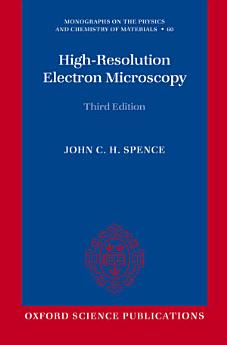High-Resolution Electron Microscopy: Edition 3
ɔtb 2008 · Monographs on the Physics and Chemistry of Materials Livre 60 · OUP Oxford
E-book
424
Pages
family_home
Éligible
info
reportLes notes et avis ne sont pas vérifiés. En savoir plus
À propos de cet e-book
The discovery of the Nanotube in 1991 by electron microscopy has ushered in the era of Nanoscience. The atomic-resolution electron microscope has been a crucial tool in this effort. This book gives the basic theoretical background needed to understand how electron microscopes allow us to see atoms, together with highly practical advice for electron microscope operators. The book covers the usefulness of seeing atoms in the semiconductor industry, in materials science (where scientists strive to make new lighter,stronger, cheaper materials), and condensed matter physics (for example in the study of the new superconductors). Biologists have recently used the atomic-resolution electron microscope to obtain three-dimensional images of the Ribosome, work which is covered in this book. The books also shows how the ability to see atomic arrangements has helped us understand the properties of matter. This new third edition of the standard text retains the early section of the fundamentals of electron optics, linear imaging theory with partial coherence and multiple-scattering theory. Also preserved are updated earlier sections on practical methods, with detailed step-by-step accounts of the procedures needed to obtain the highest quality images of the arrangement of atoms in thin crystals using a modern electron microscope. The sections on applications of atomic resolution transmission electron microscopy (HREM) have been extensively updated, including descriptions of HREM in the semiconductor industry, superconductor research, solid state chemistry and nanoscience, as well as metallurgy, mineralogy, condensed matter physics, materials science and biology. Entirely new sections have been added on electron holography , aberration correctors, field-emission guns, imaging filters, HREM in biology an don organic crystals,super-resolution methods, Ptychography, CCD cameras and Image plates. New chapters are devoted entirely to scanning transmission electron microscopy and Z-contrast, and also to associated techniques, such as energy-loss spectrocospy, Alchemi, nanodiffraction and cathodoluminescence. Sources of software for image interpretation and electron-optical design are also given.
À propos de l'auteur
John Spence is a Fellow of the American Physical Society and of the Institute of physics, a recent co-editor of Acta Crystallographica and serves on the editorial board of Reports on Progress in Physics. He also serves on the Scientific Advisory Committee of the Molecular Foundary and the Advanced Light Source at the Lawrence Berkeley Laboratory. He is a member of the International Union of Crystallography's Commission on Electron Diffraction, and winner of the Burton award of the Microscopy Society of America.
Donner une note à cet e-book
Dites-nous ce que vous en pensez.
Informations sur la lecture
Smartphones et tablettes
Installez l'application Google Play Livres pour Android et iPad ou iPhone. Elle se synchronise automatiquement avec votre compte et vous permet de lire des livres en ligne ou hors connexion, où que vous soyez.
Ordinateurs portables et de bureau
Vous pouvez écouter les livres audio achetés sur Google Play à l'aide du navigateur Web de votre ordinateur.
Liseuses et autres appareils
Pour lire sur des appareils e-Ink, comme les liseuses Kobo, vous devez télécharger un fichier et le transférer sur l'appareil en question. Suivez les instructions détaillées du Centre d'aide pour transférer les fichiers sur les liseuses compatibles.










